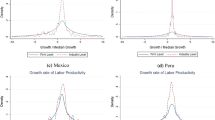Abstract
We study the productivity, financial and distributional performance of the United States Postal Service subsequent to its 1971 reorganization. We investigate the magnitude and the economic drivers of productivity change (technical change, change in cost efficiency, and scale economies), and we investigate the distribution of the financial benefits of productivity change (among consumers of postal services, postal employees and other resource suppliers, and residual claimants). We find improvements in technology to have been the main driver of, and diseconomies of scale to have been the main drag on, productivity change. We find labor to have been the main beneficiary, and consumers of postal services the main losers, from postal reorganization.
Similar content being viewed by others
References
Bennet T.L. (1920). The theory of measurement of changes in cost of living. Journal of the Royal Statistical Society 83: 455–462
Cohen, R., Robinson, M., Scarfiglieri, G., Sheehy, R., Conandini, V.V., Waller, J., & Xenakis, S. (2004a). The role of scale economies in the cost behavior of posts. http://www.prc.gov. Accessed 3 September 2006.
Cohen, R. H., Robinson, M., Sheehy, R., Waller, J., & Xenakis, S. (2004b). Postal regulation and worksharing in the U.S. http://www.prc.go. Accessed 3 September 2006.
Davis H.S. (1955). Productivity accounting. Philadelphia, University of Pennsylvania Press
Denny M., Fuss M., Waverman L. (1981). The measurement and interpretation of total factor productivity in regulated industries, with an application to Canadian telecommunications. In: Cowing T.G., Stevenson R. (eds) Productivity measurement in regulated industries. New York, Academic Press, pp. 179–218
Diewert W.E. (2005). Index number theory using differences rather than ratios. American Journal of Economics and Sociology 64(1): 347–395
Fama E.F., Jensen M.C. (1983). Agency problems and residual claims. Journal of Law & Economics 26(2): 327–349
Geddes R. (1998). The economic effects of postal reorganization. Journal of Regulatory Economics, 13: 139–156
Geddes R. (2003). Saving the mail. Washington DC, The AEI Press
Geddes R.R. (2005). Reform of the U.S. postal service. Journal of Economic Perspectives 19(3): 217–232
Grifell-Tatjé E., Lovell C.A.K. (1999). Profits and productivity. Management science 45(9): 1177–1193
Kendrick, J. W., & Creamer, D. (1961). Measuring company productivity: Handbook with case studies. Studies in Business Economics 74. New York: The Conference Board.
Lawrence D., Diewert W.E., Fox K.J. (2006). The contributions of productivity, price changes and firm size to profitability. Journal of Productivity Analysis 26(1): 1–13
Miller D.M. (1984). Profitability = Productivity + Price Recovery. Harvard Business Review 62(3): 145–153
President’s Commission on the United States Postal Service (2003). Embracing the future: Making the tough choices to preserve universal mail service. http://www.treas.gov/offices/domestic-finance/usps. Accessed 3 September 2006.
Puiseux, L., & Bernard, P. (1965). Les Progrès de Productivité et Leur Utilisation a L’Électricité de France de 1952 a 1962. Études et Conjoncture, Janvier, 77–98.
Sappington D.E.M., Sidak J.G. (2003). Incentives for anticompetitive behavior by public enterprises. Review of Industrial Organization 22(3): 183–206
US Department of Labor, Bureau of Labor Statistics (2007). Multifactor productivity trends, 2005. http://www.bls.gov/mf.. Accessed 3 September 2006.
United States Postal Service (USPS) (2003). The United States postal service: An American History, 1775–2002. http://www.usps.com/cpim/ftp/pubs/pub100.pd. Accessed 3 September 2006.
United States Postal Service (2004). 2004 United States Postal Service Annual Report. http://www.usps.com/history/anrpt04. Accessed 3 September 2006.
Author information
Authors and Affiliations
Corresponding author
Rights and permissions
About this article
Cite this article
Grifell-Tatjé, E., Lovell, C.A.K. Productivity at the post: its drivers and its distribution. J Regul Econ 33, 133–158 (2008). https://doi.org/10.1007/s11149-007-9051-y
Published:
Issue Date:
DOI: https://doi.org/10.1007/s11149-007-9051-y




